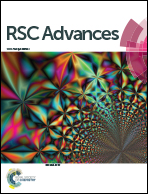Scalable asymmetric synthesis of a key fragment of Bcl-2/Bcl-xL inhibitors†
Abstract
The asymmetric synthesis of a 1,3-diamine building block for the elaboration of Bcl-2 and Bcl-xL protein inhibitors is described through two key steps: (1) a highly diastereoselective aza-Reformatsky reaction, and (2) a chemoselective amination under Mitsunobu conditions. This synthetic sequence was also demonstrated to be successfully amenable to a large-scale synthesis.


 Please wait while we load your content...
Please wait while we load your content...